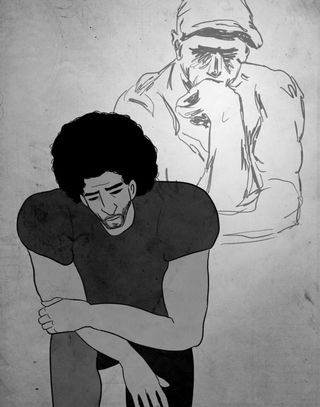Psychoanalysis
Kaepernick's Taking a Knee
The time to reflect is perhaps more important now than ever.
Posted October 30, 2017

When Colin Kaepernick faced the flag and took a knee during the playing of the national anthem, it was widely understood to be a form of protest. I believe that this is a misinterpretation of the gesture’s spirit. It is a misinterpretation born out of the same mistrust of the other that leads to much of the senseless violence it intends to expose. If approached with openness, the gesture invites us to consider the importance of stopping the violence in society, as it does in football, and join him in quiet reflection.
At opposite ends of the opinion spectrum, Kaepernick’s gesture has been characterized as legitimate and courageous, and illegitimate and disrespectful. His taking a knee has been compared to Tommie Smith’s and John Carlos’ masterful gesture, raising their fists at the 1968 Olympics medal ceremony. The difference between these two gestures, however, is significant.
Outside the Sport vs. Inside the Sport
As track and field athletes, Carlos and Smith ran the 200-meter dash, an event in which the athletes are clearly separated into lanes. There is no physical contact. The raised fist plays no part in it; it is outside the sport. Unrelated to their sport, it was a clear gesture of protest.
By comparison, taking a knee has a special meaning in football, particularly for the quarterback. According to the Official Playing Rules of the NFL, “Dead ball declared … when a quarterback immediately drops to his knee.” It is an integral part of the rules—it is inside the sport.
Taking a knee is a means of putting a halt to the blinding intensity, violence, and speed of the game. It calls for an immediate pause in the play and a return to the huddle in order to consider the next play. It is the opposite of a call to action.
Fight vs. Truce
Carlos and Smith’s raised fists put the body in full extension and ready to act, to fight. When a player takes a knee, he is vulnerable. It is like he is calling for a truce. For this reason, any contact is strictly forbidden and results in severe penalties. It is seen as not just a foul but as a cheap shot.
Taking a knee calls upon us to respect the person’s defenselessness. Far from challenging the other to a fight or argument, taking a knee folds the body into a humbling position. Through this deferential body language, Kaepernick challenges us to stop and reflect on the humanity of the victims to whom he is drawing our attention. Precisely in a sport where power and force is central, the gesture speaks truce to power.
Taking a Knee is Subversive
Although it is not a protest, taking a knee in the context of the National Anthem is subversive. It is a powerful critique, especially in a political climate in which screaming our unreflective opinions calls upon the other to scream their opinions even louder. Taking a knee derails this momentum. Insisting on the mental and physical space to reflect disrupts the status quo. Like Rodin’s meditative sculpture, The Thinker, it invites contemplation.
We can, of course, refuse the invitation to reflect and insist that it is a form of disrespectful protest that calls for a harsh reaction. But I believe that this is a misinterpretation of the gesture’s spirit. A man kneeling in a crowd as if in silent prayer is certainly an arresting image, but it is not one of disrespect. It is one that will hopefully inspire us to stop and think—something we all need to do, perhaps now more than ever.
Colin Kaepernick’s gesture has certainly triggered reflection in my family. In addition to an ongoing discussion of the topic at home, my daughter, Sophie, was inspired to make the artwork for this piece. My daughter, Emilie, has written a paper on the topic for her media studies course; and the gesture has been present at each of her college soccer games where it is common for some players to take a knee.
Pascal Sauvayre, Ph.D., is a psychoanalyst in private practice in NYC. He is on the faculty of and a Supervising Analyst at the William Alanson White Institute. He is an Executive Editor of the journal Contemporary Psychoanalysis.




